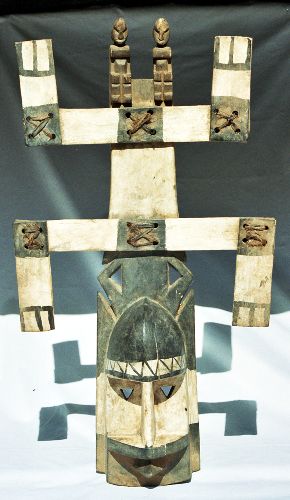Kanaga mask (sold)
 |
90 cm high reproduction of a kanaga mask, made by a
Dogon artisan.
The face has a triangular structure. The cross-of-Lorraine superstructure type represents actually the outstretched wings of a mythical bird, the komondo, and reports to the creation myth. The triangular shape of the face is the upper jaw of the bird, and the conical form below it is the tongue. According to certain myths, the superstructure is the God's hand. The two small figures on the top represent the first human couple to which the Dogon traced their origin. The higher part of the cross symbolizes the supernatural world, and the lower part symbolizes the society world. The union between both worlds is the line that joins the higher and the lower part of the cross. In ritual ceremonies, the carrier of the mask dances, pointing out the cross towards the ground, to connect earth and heaven. In funeral ceremonies, members of the Awa society wore these masks when dancing on the roof of dead's house in order to lead his soul (nyama) to its resting place and, at the same time, to defend the survivors from the harm a wandering soul might inflict upon them. After the ceremony, they considered the deceased man as an ancestor (from Ladislas Segy's "Masks of West Africa" ). The masks are also worn to protect hunters against the revenge of the animal he has killed. |